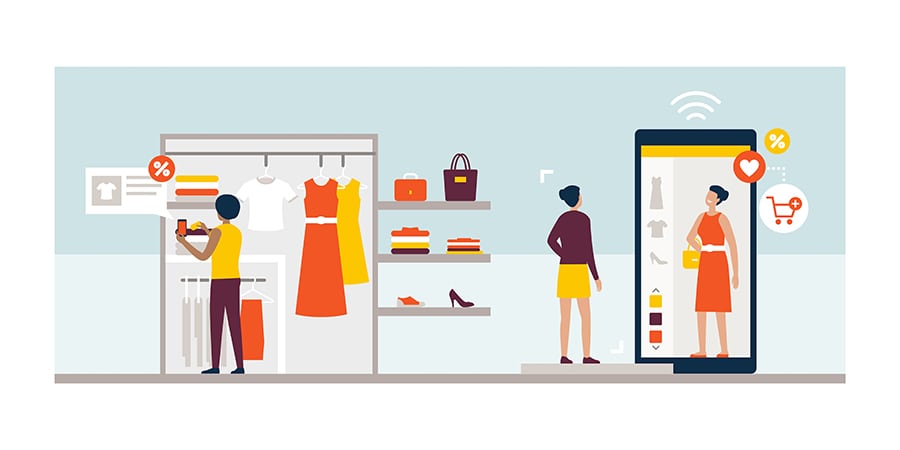Shopping is changing. The world we live in today has twice as many brands as it did 20 years ago. The barrier for companies to enter the market has diminished while the platforms to sell, discover, and advertise those products has become increasingly saturated. The platforms of the technology age such as Facebook, Instagram, Etsy, and YouTube have increasingly become clogged with new brands, paid advertising, and content.
Traditional advertising of showcasing a “cheap deal” and driving them to a website store is no longer attracting shoppers. Their attention is drawn to so many different deals that they have become desensitized to the advertisements and are no longer converting to ecommerce websites. Customers have so much optionality on where they shop that brands need to find unique ways to stand out and drive engagement to their point of purchase.
Experiential Shopping
Headless commerce, the ability to decouple the logistics aspect of the buying experience (order management, inventory management, and shipping carrier software such as EasyPost) to the customer-facing experience, is allowing businesses to engage their potential customers in new and exciting ways. Voice shopping, video games, IoT, kiosks, billboards, smart mirrors, VR/ AR, wearables, and vending machines are all channels in which brands are now exploring to create brand awareness and drive consumers to new points of purchase.
Voice-Activated Purchasing
Digital Commerce 360 led a research report that stated: “20% of consumers who own voice-activated speakers are using them for some shopping-related activities.” With over 70 million Amazon Alexa speakers sold each quarter in the US, the potential for brands to engage with their customer base is enormous. Companies like VoiceFront and Voice2Biz are low code plug-ins that can enable merchants with the ability to sell via voice without investing heavily in the channel.
The Paradigm Shift in Brick-and-Mortar
The brick-and-mortar purchasing experience is changing as well. High-touch customer service, interactive exhibits, and engaging displays are all becoming more prevalent. Smart mirrors are the new trend to provide a unique buying experience and a new point of purchase. According to research by retail consultant Paco Underhill, “71% of customers who try something on in a fitting room will go on to buy something.” This makes the fitting room a unique space that retailers can utilize to boost sales. Companies such as LVMH, Lululemon and Ralph Lauren have realized the importance of engaging customers at points where they have purchase intent.
LVMH’s MemoryMirror shows you a 360-degree view of yourself with the outfit on and allows you to compare outfits side-by-side. You can also snap photos of yourself to share with friends on Facebook before you make your purchase. Ralph Lauren’s smart mirror can adjust the lighting in your fitting room and gives you the ability to select different sizes or colors of your outfit, which an employee will immediately get for you. It also recommends other items that would go with your outfit. If you don’t want to buy something that day, the mirror sends the information of the item to your mobile phone in hopes that you’ll make a future purchase.
Today, brick-and-mortar plays less of a role in retail with the growth of ecommerce. Therefore, brands need to ensure that customers visiting stores are converting. Smart mirrors play a further role into the future of shopping as businesses are looking to reduce costs. Smart mirrors enable shoppers to order through the device and have items shipped to their home, thus reducing the need for in-store inventory.
The Perfect Mix of Content and Sales
The future of shopping involves a highly blended mix of content and sales. YouTube, Twitch, and other video content sites are now channels that brands can utilize as points of purchase. Companies such as Facebook have invested heavily in turning video content such as livestreams and influencer content into potential sources for brands to advertise and convert into a purchase. In 2019, Facebook acquired Package, which enables any video content to be a point of purchase in as little as one click. As influencers become more influential to fashion trends, brands need to align themselves with those people and where they spend their time, which is increasing on video through platforms such as TikTok and Instagram.
As we look to the future, the shopping experience has completely evolved into a highly experiential process where customers expect high-quality service and curated products at places where they spend their time, and unique experiences all without the hassle of worrying about the logistics of where they buy the product or how it gets to them. As brands think about shopping, they need to continually think about how they can provide an engaging and truly omnichannel experience.
The What
Experiential retail is going to impact shoppers in the future. As businesses look to stand out and create a connection with shoppers they will need to think about different ways to engage with their customer base. Voice-activation, smart mirrors, and video purchasing are only a few new channels that brands can now experiment with to create a true omnichannel experience driving customers to multiple points of purchase.
The Why
Experiential retail is important for merchants to be aware of as standing out from competitors becomes increasingly difficult, with advertising becoming saturated and consumers becoming more desensitized to targeted marketing. Being able to stay top-of-mind and engage with customers with their undivided attention will be key to driving sales in an online and offline ecosystem.
The How
Experiential shopping is evolving from experimental technology to fundamentally changing how people view the shopping experience. The evolution from brick-and- mortar to ecommerce changed the face of shopping. Technology combined with high- touch experiences will be an even bigger trend in moving shopping from a dedicated thought process to brands interacting with people in their everyday lives in more engaging ways.



